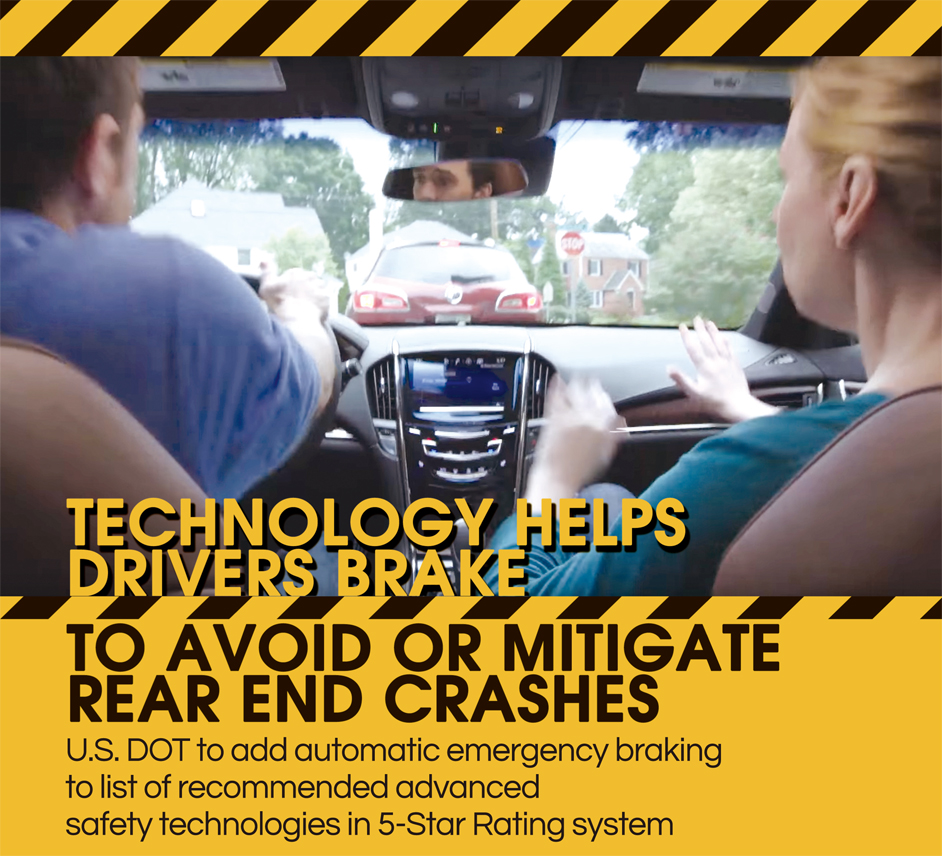
by Kathryn Henry, November 2, 2015
WASHINGTON — The U.S. Department of Transportation's National Highway Traffic Safety Administration (NHTSA) today announced that beginning with model year 2018, the agency will update its 5-Star Rating System to include automatic emergency braking (AEB) as a recommended safety technology. It will provide consumers with new information on technology with the potential to prevent rear end crashes or reduce the impact speed of those crashes by automatically applying the brakes.
"We are adding automatic emergency braking features to the 5-Star Rating System because crash avoidance technologies can save lives and should be widely accessible," said U.S. Transportation Secretary Anthony Foxx. "AEB can substantially enhance safety, especially with the number of distracted drivers on the road."
AEB systems work with or without driver intervention by combining inputs from forward looking radar and/or camera sensors and driver inputs to determine if a rear end crash is likely to happen. Specifically, AEB technology includes two systems:
crash imminent braking (CIB), which applies the brakes in cases where a rear end crash is imminent and the driver isn't taking any action to avoid the crash, and
dynamic brake support (DBS), which supplements the driver's braking input if the driver isn't applying sufficient braking to avoid a rear end crash.
"We're putting the brakes on rear end crashes," said NHTSA Administrator Mark Rosekind. "Wherever possible, NHTSA will encourage and accelerate technological innovations that save lives."

The decision is one of a series of steps NHTSA and DOT have undertaken to accelerate the spread of crash avoidance technology. In September 2015, NHTSA and the Insurance Institute for Highway Safety announced that 10 major vehicle manufacturers have committed to making AEB a standard feature on all new vehicles. NHTSA is also completing a proposal to require transmitters for vehicle to vehicle safety communications in new cars, and to identify and address potential obstacles to safety innovations within its existing regulations.
To help the public better understand how AEB works, the agency has created a new AEB webpage on www.safercar.gov/AEB. The page has a compelling video depicting a scenario where AEB is used to prevent a crash, a demonstration depicting the two types of AEB applications, and information about the current state of the technology.
The agency first included recommended advanced safety technologies as part of the 5-Star Rating System upgrade in 2011. The list first included electronic stability control (ESC), forward collision warning, and lane departure warning. In 2014, when ESC became mandatory for all new light vehicles, NHTSA replaced ESC with another technology, rearview video systems. NHTSA intends to remove rearview video systems as a recommended technology in model year 2019, when the technology will be standard equipment on all new light vehicles.
Automatic emergency braking (AEB) systems detect an impending forward crash with another vehicle in time to avoid or mitigate the crash. These systems first alert the driver to take corrective action to avoid the crash. If the driver's response is not sufficient to avoid the crash, the automatic emergency braking system may automatically apply the brakes to assist in preventing or reducing the severity of a crash.

The National Highway Traffic Safety Administration believes these technologies represent the next wave of potential significant advances in vehicle safety. Automatic emergency braking systems, such as dynamic brake support (DBS) and crash imminent braking (CIB), have the potential not only to save lives but also to reduce moderate and less severe rear end crashes that are common on our roadways.
In 2012, one-third of all police reported crashes involved a rear end collision with another vehicle as the first harmful event in the crash, and NHTSA believes that advanced crash avoidance and mitigation technologies like AEB systems could help in this area. NHTSA's extensive research on this technology and on relevant performance measures showed that a number of AEB systems currently available in the marketplace are capable of avoiding or reducing the severity of rear end crashes in certain situations.
Two AEB systems, crash imminent braking (CIB) and dynamic brake support (DBS), have been available on some vehicle models in the United States since 2006.

Today, advanced crash avoidance technologies, such as CIB and DBS systems, are typically included in safety technology packages as optional features. Manufacturers are using a number of different sensor combinations in production level automatic emergency braking systems. The agency conducted a cost analysis of several production level systems and found that the system cost varies significantly depending on the type and number of sensors used.